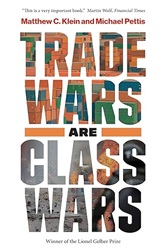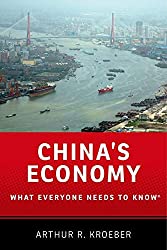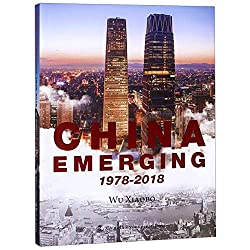
Rating: 8.1/10.
Trade Wars Are Class Wars: How Rising Inequality Distorts the Global Economy and Threatens International Peace by Matthew C. Klein and Michael Pettis
Book by two economists and analyzes the macroeconomic situation of trade wars, primarily between the US and China, but also involving other countries. The root of these trade conflicts is domestic inequality: Chinese workers, unable to afford the goods they produce, must sell them abroad, leading to trade imbalances. The proposed solution is to increase the wealth of these workers, enabling them to buy the products they make.
The current macroeconomic trade situation is quite different from the classical economic theory of Adam Smith. Smith envisioned trade in finished products across borders, where different countries excel in producing distinct items, but now most trade is of intermediate products. However, the internationalization of intermediate products wasn’t prevalent until after the 1970s, primarily due to the complexities of shipping. This changed with the advent of containerization, which drastically reduced port costs by enabling end-to-end shipping of containers. The book analyzes data from trade and exports, but there are data issues with countries commonly used as tax havens, such as Ireland, Singapore, and some Caribbean nations, these countries are widely used by multinational companies to almost entirely avoid corporate tax. Consequently, many statistics related to exports from these tax havens are considered not truly representative of the economic reality.
There have been various cycles of foreign investment over the last 200 years, predominantly from European financial centers to developing countries and the Americas, including the United States. In many of these instances, there is initially a period of optimistic investment, but not all of these investments yield returns, often leading to subsequent defaults as they fail to enhance productivity and struggle to make interest payments.
The next chapter explores the theory of sectoral balances, a set of accounting identities designed to elucidate the relationship between investment, consumption, exports, etc., among countries. The most fundamental concept of this theory is that any production must either be consumed or used for investment. Consumption improves the quality of life in a country, whereas investment is geared towards enhancements that will increase productivity and quality of life in the future. When a country seeks investment, it can do so in two primary ways: through domestic savings, which are diverted from consumption to investment, and through foreign investment. China and Soviet Russia, for instance, were able to allocate outputs from their peasant populations into infrastructure investments, eg: Russia selling its grain, leading to famine, in order to purchase German technology. The second method is to attract investment from abroad, particularly from countries with higher savings rates looking to invest externally due to insufficient domestic opportunities for productive investment. However, this breaks down when a country is already developed and cannot productively utilize additional investments, so in these cases, high savings rates lead to reduced consumption and lower living standards without any expectation of future improvements in productivity.
The rest of the chapters talk about the economies of China, Germany, and the US. China’s economic narrative starts with Deng Xiaoping in the 1980s; China experienced rapid growth as it opened up, making all the easily productive investments until around the mid-1990s. However, since then, the income of the working class has stagnated, leading to the highest savings rate in the world, as most of the surplus income goes to the elites. The savings have been channeled into domestic investments of dubious productivity, such as bridges and railways in sparsely populated areas, while the rest of the savings have been directed towards foreign investments, with a noticeable increase in capital flight since the mid-2010s. China’s financial system is regressive; there is almost no income tax, resulting in the working class consuming much less than they produce. China has an export economy to prevent rising unemployment; production is exported because the working class cannot afford what they produce, and domestic consumption remains low.
The situation in Germany bears some resemblance to that of China. Following German reunification in 1989, East Germany rapidly integrated with the West. However, the East German cheap labor led to depressed wages, particularly in West Germany, which resulted in a scenario similar to China’s, where the elites captured a large portion of the income, leading to a high savings rate. Initially, these savings were invested in other parts of Europe, such as Spain and Greece, but following the financial crisis, The EU adopted a policy of a debt freeze, committing to not spending more than what they could generate in taxation, rather than borrowing to increase consumption. This shift in policy led to Germany’s surplus being invested not within Europe, but abroad, in the rest of the world.
America adopted a stance contrary to that of China and Germany in the post-war economy; US assets became the preferred reserve currency, and US bonds emerged as the favored savings instrument for the rest of the world, including China and Europe. This preference was not due to high returns on investment, but rather because of the perceived safety. Consequently, this situation led to a significant accumulation of debt in the US, as it was able to borrow at nearly zero interest rates. This environment fostered a number of questionable investments, such as property mortgages, which ultimately triggered the 2008 financial crash and housing crisis. Overall, this has been detrimental to the American working class; it has depressed domestic manufacturing, rendering it non-competitive with the rest of the world, since the USD is artificially inflated.
In conclusion, domestic consumption has become the scarce resource, with China and Germany as the primary contributors to this problem by suppressing their domestic consumption. This leads to the US working class bearing the burden of absorbing all the excess investment from these countries. The authors suggest that China and Germany should boost their domestic consumption by increasing taxes on the wealthy class and implementing a combination of government stimuli aimed at the working class.



